The Association for Bahá’í Studies conference: advancing a conversation
It was one hundred and four years ago that the footsteps of One who manifested both majesty and servitude, down to His very gait, were impressed upon Montreal’s earth. On the evening of August 30, 1912, the Master would arrive at Windsor station in Montreal, greeted by two carriages—a world away from the modern car that would meet Him today. The roads that would carry Him to the Maxwell’s home—later designated a Shrine by the pen of His beloved grandson—trace a map that is scarcely recognizable when overlaid with the bustling city’s present topography. But the echo of that precious time perhaps may be found, not in its outward form, but deeper still, in the substance of ‘Abdu’l-Bahá’s visit to the West.
“Tomorrow, we will raise the Call of God in this place,” spoke the Master when travelling past the Unitarian Church. In that address, and the others during His time in Montreal, He would share Bahá’u’lláh’s vision of a new world through exploration of the requisites for building a materially and spiritually prosperous civilization. He spoke on such subjects as the essential oneness of humanity, the oneness of religion, the standard of universal education, the equality of women and men, and global governance, among others. His words echoed in churches and clubs, and filled the intimate setting of homes, imparting such revolutionary ideas to a multitude of souls and drawing with His words the outline of a humanity characterized by its spiritual maturity. He tirelessly and without surcease expounded the verities of His Father’s Revelation with precision, speaking pointedly to the exigencies of the age and the challenges that plagued the communities He addressed.
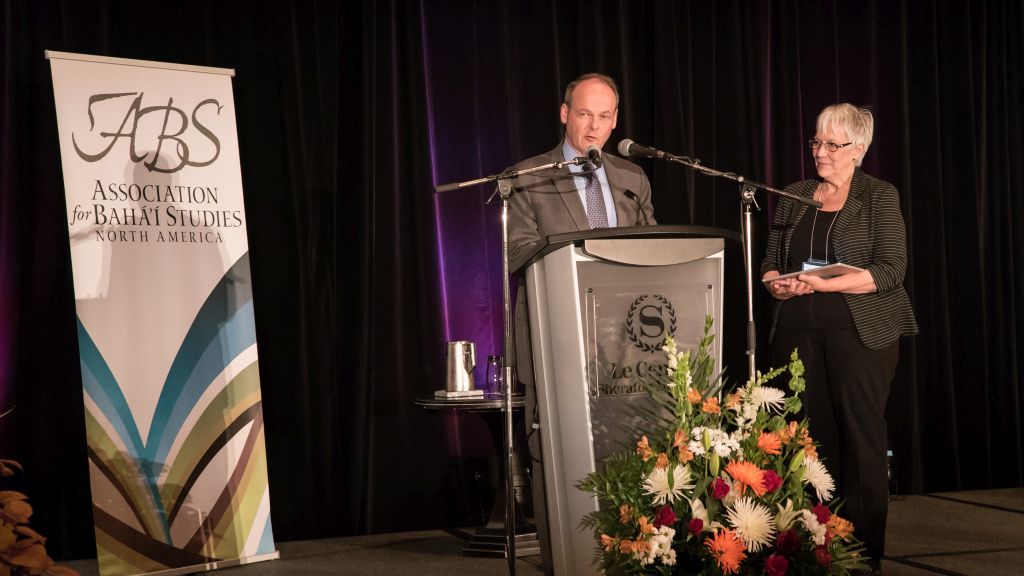 More than a century since the gift of the Master’s presence in Montreal, a city hallowed by His memory, members of the North American Bahá’í community together with friends from other parts of the world gathered for the 40th annual conference of the Association for Bahá’í Studies. The gathering, which attracted more than 1,500 individuals, vibrated with the same purpose that brought the Master to the West. Friends came together in a thoughtfully arranged setting to engage with a program, which at its core was a deliberation on how the verities enshrined in Bahá’u’lláh’s Revelation can increasingly and more effectively be brought to bear on every sphere of study and every arena of action. The conference is one space in which the Association is learning about how the intellectual life of the Bahá’í community can be fostered, presenting an invaluable opportunity for collaboration around certain areas of inquiry.
More than a century since the gift of the Master’s presence in Montreal, a city hallowed by His memory, members of the North American Bahá’í community together with friends from other parts of the world gathered for the 40th annual conference of the Association for Bahá’í Studies. The gathering, which attracted more than 1,500 individuals, vibrated with the same purpose that brought the Master to the West. Friends came together in a thoughtfully arranged setting to engage with a program, which at its core was a deliberation on how the verities enshrined in Bahá’u’lláh’s Revelation can increasingly and more effectively be brought to bear on every sphere of study and every arena of action. The conference is one space in which the Association is learning about how the intellectual life of the Bahá’í community can be fostered, presenting an invaluable opportunity for collaboration around certain areas of inquiry.
In a letter written on behalf of the Universal House of Justice to the National Spiritual Assembly of the Bahá’ís of Canada regarding the Association and its direction, it states:
…[T]here are ‘a great many Bahá’ís who are engaged as individuals in social action and public discourse through their occupations.’ Every believer has the opportunity to examine the forces operating in society and introduce relevant aspects of the teachings within the discourse prevalent in whatever social space he or she is present. It is, perhaps, as a means to enhance the abilities of the friends to explore such opportunities in relation to their scholarly interests that the endeavours of the Association for Baha’i Studies can be conceived. Through the specialized settings it creates, the Association can promote learning among a wide range of believers across a wide range of disciplines. [1]
The Association’s beginnings
 The Association for Bahá’í Studies, then called “The Canadian Association for Studies in the Bahá’í Faith,” was born out of a letter from the Universal House of Justice addressed to the National Assembly of Canada in 1975. The letter outlined goals specific to Canada during the Five Year Plan from 1974 to 1979. In that letter, the Bahá’í community was tasked with cultivating “opportunities for formal presentation, courses and lectureships on the Bahá’í Faith in Canadian universities and other institutions of higher learning.”
The Association for Bahá’í Studies, then called “The Canadian Association for Studies in the Bahá’í Faith,” was born out of a letter from the Universal House of Justice addressed to the National Assembly of Canada in 1975. The letter outlined goals specific to Canada during the Five Year Plan from 1974 to 1979. In that letter, the Bahá’í community was tasked with cultivating “opportunities for formal presentation, courses and lectureships on the Bahá’í Faith in Canadian universities and other institutions of higher learning.”
In response to this call and a number of other tasks, the National Assembly convened a “policy conference”, a device the Assembly had used in the Nine Year Plan in connection with Arctic teaching, among other things. It consisted of inviting a group of 20 or so believers who represented every region in the country and who were selected on the basis of their connection to the topic under consideration. They would spend a weekend together in a “free-flowing discussion,” in this case, on the question of cultivating opportunities for formal presentations of the Faith at institutions of higher learning. This took place in Ottawa, Ont. in late January 1975. Based on their discussion, those gathered would make a number of recommendations, which the National Spiritual Assembly would take under advisement.
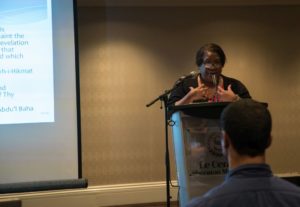 The group’s discussion determined that the goal defined by the House of Justice did not refer to Bahá’í teaching activities, but to the development of a formal academic program acceptable to institutions of higher
The group’s discussion determined that the goal defined by the House of Justice did not refer to Bahá’í teaching activities, but to the development of a formal academic program acceptable to institutions of higher 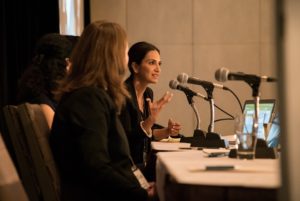 learning, on the basis of the same very strict criteria as other university programs.
learning, on the basis of the same very strict criteria as other university programs.
“I think [they] realized that before we could approach universities, or as we approach universities, there had to be some body of scholarship on the Faith,” explained Dr. Gerald Filson, who has participated in the conference for many years.
As noted in Bahá’í Canada in the March/April 1975 issue, one step was “to recognize that, so far as formal academic lectures on the Cause were concerned, the House of Justice envisions a long-range, carefully developed and staged approach.”
“We are not asked immediately to secure invitations to present formal courses on the Faith, but to ‘cultivate opportunities’ that will make this possible,” the article continued.
The proposal borne out of that conference was for the National Assembly to encourage the formation of an “association,” much like other professional and academic societies, which would be largely self-supporting through the fees of its members, and would be open to interested and qualified Bahá’ís. The vision was that it could gradually win recognition as a source for responsible lectureships, course materials and research assistance on the Bahá’í Faith.
The National Assembly accepted the proposal, and took steps to encourage the establishment of “The Canadian Association for Studies on the Bahá’í Faith.”
The first conference was convened in early January of 1976, at Cedar Glen, a conference centre north of Toronto, Ont. The Executive Committee expected no more than 50 or so participants, due to bad weather and a postal strike that prevented them from providing adequate notice to members. Eighty participants from all across Canada turned up. There were seven speakers presenting papers in a wide range of academic disciplines, as well as a presentation by “Ballet Shayda,” which consisted of three dances.
As part of the conference, the Association held its formal Annual Meeting on Saturday afternoon, in order to review work to date and discuss the next stage in the Association’s work. Many resolutions were passed, among them the launch of a publication titled Bahá’í Studies, the beginning of what is known today as The Journal of Bahá’í Studies. The first issue would carry the proceedings of the Annual Meeting and the full text of all the papers presented.
The evolution of the Association and the conference
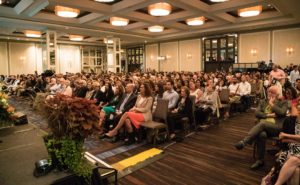 Today, the conference maintains an annual attendance of more than 1,000 participants. While some elements of the conference and the association have remained relatively consistent, certain features have evolved and emerged in more recent years, as the Bahá’í community has learned how to advance a systematic process of growth in the field of expansion and consolidation, and as consideration is being given to how learning from the field of expansion and consolidation can be applied to the area of contributing to discourse.
Today, the conference maintains an annual attendance of more than 1,000 participants. While some elements of the conference and the association have remained relatively consistent, certain features have evolved and emerged in more recent years, as the Bahá’í community has learned how to advance a systematic process of growth in the field of expansion and consolidation, and as consideration is being given to how learning from the field of expansion and consolidation can be applied to the area of contributing to discourse.
Perhaps a notable insight in regards to expansion and consolidation that will help the Association advance is the notion that “this is a Faith for agency and action,” said Dr. Michael Karlberg, a participant of the conference who has assisted the Association in various ways and served for a period of time as the secretary of the Executive Committee.
“… It’s a Faith where we don’t have a clergy or a bunch of experts who do the work for us,” continued Dr. Karlberg. “And really the Association for Bahá’í Studies is another space where we really need to cross that threshold and recognize this is an active working space.”
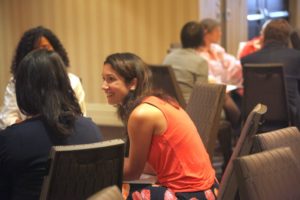 “It’s not where we come for a little inspiration or entertainment—it’s where we come to work together and work towards this vision that the House has laid out, in an active way.”
“It’s not where we come for a little inspiration or entertainment—it’s where we come to work together and work towards this vision that the House has laid out, in an active way.”
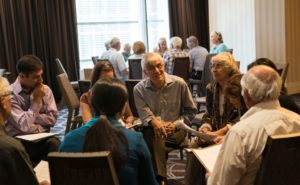 This move towards a systematic and collective learning process was evident in one of the first sessions of the conference held on Thursday morning. It was devoted to studying a small compilation of guidance from the Universal House of Justice related to contributing to the discourses of society. The participants studied the guidance in small groups, allowing for wider and more active participation, and explored relevant questions alongside the study of the material, which encouraged those gathered to reflect on how to frame their participation over the course of the next four days and beyond the confines of the conference program.
This move towards a systematic and collective learning process was evident in one of the first sessions of the conference held on Thursday morning. It was devoted to studying a small compilation of guidance from the Universal House of Justice related to contributing to the discourses of society. The participants studied the guidance in small groups, allowing for wider and more active participation, and explored relevant questions alongside the study of the material, which encouraged those gathered to reflect on how to frame their participation over the course of the next four days and beyond the confines of the conference program.
Among other things, the guidance helped participants situate the area of contributing to the prevalent discourses of society among one of three areas of endeavour in which the Bahá’í Community is engaged, which includes expansion and consolidation and social action. [2]
In considering this, the friends could gain an appreciation of how advancement in one area can yield valuable insight that may inform other areas, particularly the area of expansion and consolidation, within which the Bahá’í community has made marked gains over the last two decades.
Through the study of certain excerpts, friends were invited to reflect on the civilization-building power of the Revelation, and the manner in which one contributes to this end:
The work advancing in every corner of the globe today represents the latest stage in the ongoing Bahá’í endeavour to create the nucleus of the glorious civilization enshrined in His teachings, the building of which is an enterprise of infinite complexity and scale, one that will demand years of exertion by humanity to bring to fruition. There are no shortcuts, no formulas. Only as effort is made to draw on insights from His Revelation, to tap into the accumulating knowledge of the human race, to apply His teachings intelligently to the life of humanity, and to consult on the questions that arise will the necessary learning occur and capacity be developed. [3]
Contributing to discourse, one approach to extending the reach of the transformative power of the teachings as well as a means of drawing from the “accumulating knowledge of the human race,” was further considered in light of the notion of an evolving conceptual framework, “a matrix that organizes thought and gives shape to activities which becomes more elaborate as experience accumulates.” [4]
Some insight was gained into how a conceptual framework that continues to evolve as more and more strive to give practical expression to the Teachings of the Faith in various fields of inquiry and endeavour, leads to the development of a sound body of knowledge, which is refined through a process of action, reflection, consultation and study.
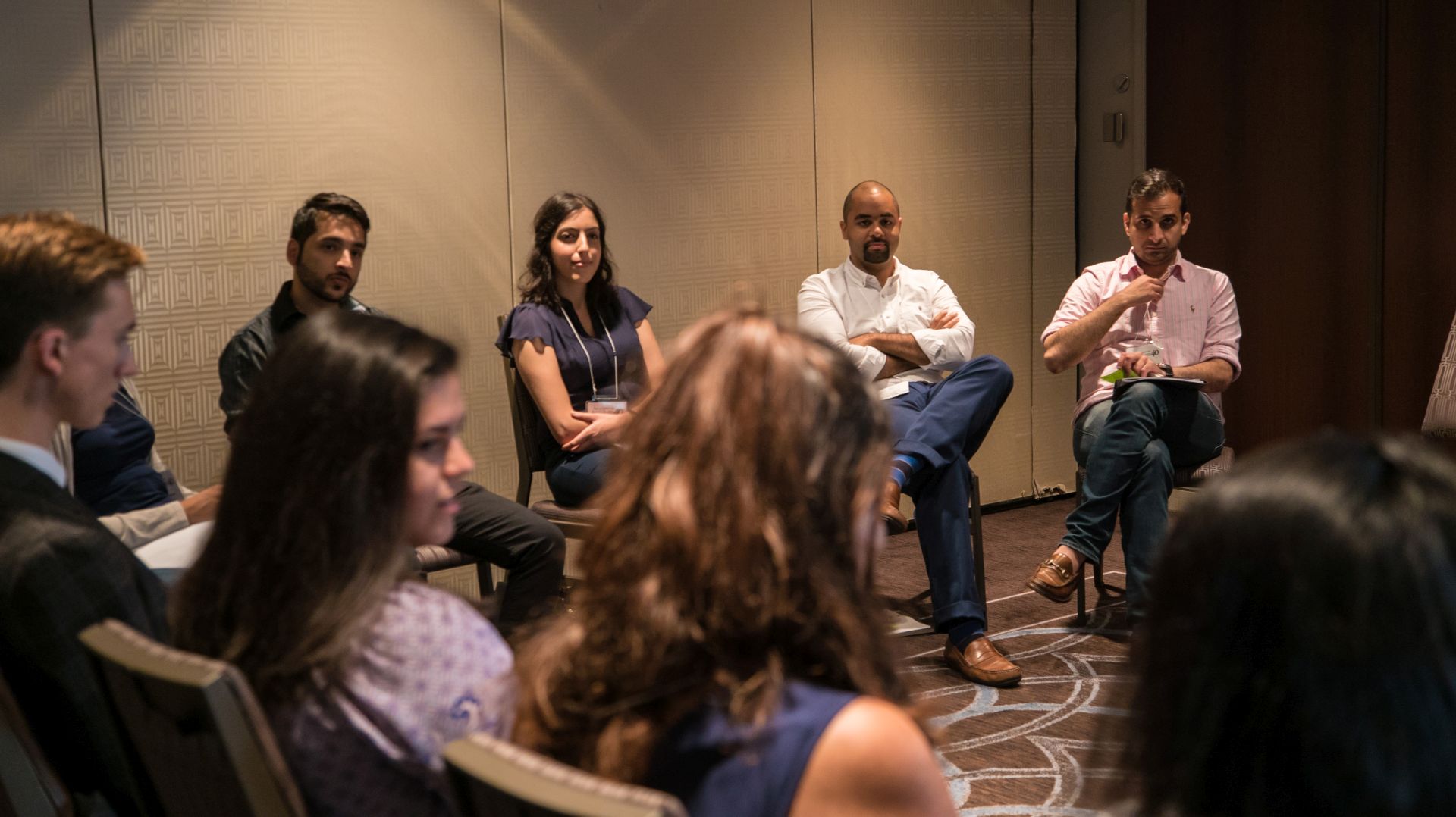 Another development in recent years is the formation of working groups in various fields. This year, 150 people participated in these meetings in the areas of health and medicine, education, law, media, economics, religion and society, technology and society, and indigenous studies.
Another development in recent years is the formation of working groups in various fields. This year, 150 people participated in these meetings in the areas of health and medicine, education, law, media, economics, religion and society, technology and society, and indigenous studies.
“Together, the participants of these groups consider how the discourses and methods prevalent in their disciplines and professions might be approached in a way that is coherent with the Bahá’í teachings” explained Geoff Cameron, a member of the executive committee, in the closing address of the conference, “so that in their studies and workplaces, they can ask new questions, contribute fresh insights and propose viable alternatives.”
“Many of these contributions will be modest, but over time, through the application of rigorous thought, we are confident that it will become more substantive and sophisticated,” said Mr. Cameron.
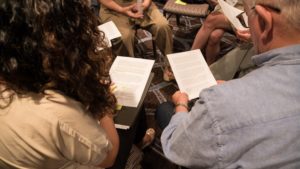 One first-time participant of the conference, a doctoral student at the University of Ottawa researching the role of grassroots movements in addressing girls’ education in Benin, participated in the education working group. She found the space presented the opportunity to explore elements of the current discourse on education that are problematic and deeply rooted.
One first-time participant of the conference, a doctoral student at the University of Ottawa researching the role of grassroots movements in addressing girls’ education in Benin, participated in the education working group. She found the space presented the opportunity to explore elements of the current discourse on education that are problematic and deeply rooted.
“…Although we had teachers, administrators, development practitioners—different areas of education and different occupations—it could be said that we were facing the same issues, whether it was gender inequality or race inequality. We were trying to understand how to remove these inequalities,” she explained.
“We were able to use the space to raise the relevant questions that we would explore in the next year, and how we would address those questions, and knowing what questions to ask and what questions to answer. With our working group we created a Facebook group. We settled on one question—the dynamics of oppression in the classroom—and our goal within this next year is to post articles and continue this discussion online to see what insights we can gain into this question.”
Dr. Karlberg elaborated on how this line of action is also drawing from learning in the field of expansion and consolidation.
“Again, very much like the framework for action in the field of expansion and consolidation, we have a framework that requires initiative, and that can’t be an entirely top down planned process by the executive committee—it has to start emerging from more and more people who grasp the vision and can think about how to start taking initiative within the framework … Then, over time, the Committee can start learning from all of those initiatives, identifying patterns that seem to be successful and effective and sharing some of that back with these groups—again, very similar to the field of expansion and consolidation.”
This year’s program
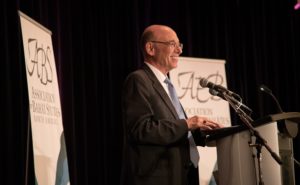 At the first conference held in 1976, there were seven presentations by individuals. This year, there were four plenary talks, five panels and 56 breakout sessions.
At the first conference held in 1976, there were seven presentations by individuals. This year, there were four plenary talks, five panels and 56 breakout sessions.
According to the conference statement, the vision of the plenary sessions is that they would help raise the vision of those gathered and to frame thinking around certain topics of general importance.
Dr. Farzam Arbab, former member of the Universal House of Justice who presented the Hasan M. Balyuzi lecture this year, spoke on the subject of the intellectual life of the Bahá’í community, exploring the question, “How deep do we have to go into the foundations of the present order to find the real causes of its defective ways?” He posited that in the effort to bring about Bahá’u’lláh’s vision of a new civilization, what must take place is a “careful and rational analysis, in light of Bahá’u’lláh’s Revelation, of today’s reality and the historical forces at work.”
“All that is being suggested is that such a careful examination should go beyond behaviour and socio-political structure and also include the intellectual foundations of the present order, at least the intellectual foundations of social, economic and political thought, and let me bold and say the intellectual foundations of culture.”
Such a careful examination should be done with “scientific and philosophical rigor,” Dr. Arbab suggests, “by minds shaped by an intellectuality that is endowed with spiritual perception,” and that it is in this manner that “the intellectual foundation for a new civilization will gradually emerge.”
Dr. Arbab went on to explain some of the conditions that may enable us to meet the challenge of developing the intellectual life of the Bahá’í community.
 On the first evening, Ms. Bani Dugal, the Principal Representative of the Bahá’í International Community (BIC) to the United Nations, shared reflections on engagement in discourses at the international level. Ms. Dugal discussed the connection between participating in the discourses of society and the promotion of the Lesser Peace, particularly discourses at the international level. There was also some exploration of what elements of the framework are critical in guiding the participation of the Bahá’í International Community, including the principle of the oneness of humanity, non-involvement in partisan politics and the role of knowledge, among others. Ms. Dugal elaborated on what components of the reality at the international level influence what, when and how the BIC engages in various discourses, and presented a number of case studies that illustrated this. The talk concluded with an emphasis on the impact of one-on-one conversations with friends and colleagues.
On the first evening, Ms. Bani Dugal, the Principal Representative of the Bahá’í International Community (BIC) to the United Nations, shared reflections on engagement in discourses at the international level. Ms. Dugal discussed the connection between participating in the discourses of society and the promotion of the Lesser Peace, particularly discourses at the international level. There was also some exploration of what elements of the framework are critical in guiding the participation of the Bahá’í International Community, including the principle of the oneness of humanity, non-involvement in partisan politics and the role of knowledge, among others. Ms. Dugal elaborated on what components of the reality at the international level influence what, when and how the BIC engages in various discourses, and presented a number of case studies that illustrated this. The talk concluded with an emphasis on the impact of one-on-one conversations with friends and colleagues.
“If we consider that all of humanity is on a path towards the advancement of civilization, we understand that our participation in discourses helps accelerate this movement. The right conversation, offered in a loving, and insightful manner, can inspire change in hearts and minds.”
On Saturday morning, Dr. Stephen Phelps delivered a talk titled: “‘The Word that shineth and flasheth amidst the books of men’: Text, translation and the nature of reality.” The topic of advancing Bahá’í inspired education was delivered by Dr. Sona Arbab on Sunday morning. These talks and a number of the panels are now available for viewing online.
A culture of learning
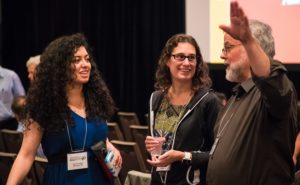 “The conferences are spaces to try and nurture the intellectual life of the Bahá’í community,” said Dr. Karlberg.
“The conferences are spaces to try and nurture the intellectual life of the Bahá’í community,” said Dr. Karlberg.
“… I think so many of the elements of what we’re learning in the field of expansion and consolidation apply,” he explained,” but they take on maybe a slightly different expression.”
One such insight is that “there is a power in collective learning,” continued Dr. Karlberg, “where we can draw on processes of consultation, study, on reflection and action, and learn together in ways that individuals alone can’t access.”
Other insights, according to a letter written on behalf of the Universal House of Justice regarding the Association for Bahá’í Studies, are:
[T]he relationship between study and action, the need for focus, which is not to be confused with uniformity, the challenge of fostering the capacity of individuals and accompanying others in service, the dynamics of organic development, the institutional arrangements necessary to sustain ever more complex patterns of activity, the coherence required among all areas of endeavour, and sound relations among individuals, the community, and the institutions. [5]
According to this same letter, perhaps chief among the elements of the framework that are most relevant to the Association is “learning in action”:
… [T]he friends participate in an ongoing process of action, reflection, study, and consultation in order to address obstacles and share successes, re-examine and revise strategies and methods, and systematize and improve efforts over time.
 In regards to how the Executive Committee is learning in action, Dr. Karlberg explained that there are a number of close collaborators who are “continually observing, listening and finding time to reflect together on many processes across the conference: the nature and effectiveness of the plenary sessions, the arts program, these working groups that are emerging, the quality and nature of the environment that’s created and how it supports those things.”
In regards to how the Executive Committee is learning in action, Dr. Karlberg explained that there are a number of close collaborators who are “continually observing, listening and finding time to reflect together on many processes across the conference: the nature and effectiveness of the plenary sessions, the arts program, these working groups that are emerging, the quality and nature of the environment that’s created and how it supports those things.”
One way in which the community can help the development of the space of the conference and the Association overall, is to actively engage with it, said Dr. Karlberg, “as well as by encouraging the flow of young people into these processes, so that as they’re forming their own intellectual frameworks in their studies, for instance, they’re also participating and contributing actively to these learning processes in ABS.”
[1] From the Universal House of Justice to the National Spiritual Assembly of the Bahá’ís of Canada, 24 July 2013.
[2] At this stage in your development, the House of Justice encourages you to begin to examine the work of your community in terms of three broad areas of action, which, though distinct from one another, each with its own methods and instruments, must achieve a high degree of coherence between them, if they are to reinforce one another and lend substantial impetus to the movement of the Australian people towards the spiritually and materially prosperous civilization envisioned in the writings of the Faith. What will ensure this coherence is the process of systematic learning that characterizes them all.
The expansion and consolidation of the Bahá’í community itself can be regarded as one area of action, the approach, methods and instruments of which are now well understood. Social action can be considered another….
Efforts to participate in the discourses of society constitute a third area of action in which the friends are engaged, such participation can occur at all levels of society, from the local to the international, through various types of interactions—from informal discussion on Internet forums and attendance at seminars, to the dissemination of statements and contact with government officials. What is important is for Bahá’ís to be present in the many social spaces in which thinking and policies evolve on any one of a number of issues—on governance, the environment, climate change, the equality of men and women, human rights, to mention a few—so that they can, as occasions permit, offer generously, unconditionally and with the utmost humility the teachings of the Faith and their experience in applying them as a contribution to the betterment of society…” (From a letter written on behalf of the Universal House of Justice to the National Spiritual Assembly of the Bahá’ís of Australia, January 4, 2009)
[3] From the Universal House of Justice to the Bahá’ís of the World, Ridván 2010.
[4] From the Universal House of Justice to the National Spiritual Assembly of the Bahá’ís of Canada, 24 July 2013.
[5] From the Universal House of Justice to the National Spiritual Assembly of the Bahá’ís of Canada, 24 July 2013.







